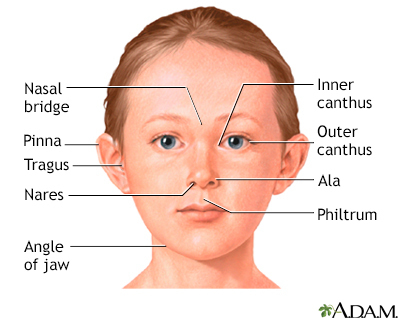Epicanthal folds
Definition
An epicanthal fold is skin of the upper eyelid that covers the inner corner of the eye. The fold runs from nose to the inner side of the eyebrow.
Alternative Names
Plica palpebronasalis
Causes
Epicanthal folds may be normal for people of Asiatic descent and some non-Asian infants. Epicanthal folds also may be seen in young children of any race before the bridge of the nose begins to rise.
However, they may also be due to certain medical conditions, including:
- Down syndrome
- Fetal alcohol syndrome
- Turner syndrome
- Phenylketonuria (PKU)
- Williams syndrome
- Noonan syndrome
- Rubinstein-Taybi syndrome
- Blepharophimosis syndrome
Home Care
In most cases, no home care is needed.
When to Contact a Medical Professional
This trait is most often found before or during the first well-baby exam. Call your health care provider if you notice epicanthal folds on your child's eyes and the reason for their presence is unknown.
What to Expect at Your Office Visit
The provider will examine the child and ask questions about the medical history and symptoms. Questions may include:
- Do any family members have Down syndrome or other genetic disorder?
- Is there a family history of intellectual disability or birth defects?
A child who is not Asian and is born with epicanthal folds may be examined for additional signs of Down syndrome or other genetic disorders.
Gallery



References
Madan-Khetarpal S, Arnold G. Genetic disorders and dysmorphic conditions. In: Zitelli BJ, McIntire SC, Nowalk AJ, eds. Zitelli and Davis' Atlas of Pediatric Physical Diagnosis. 7th ed. Philadelphia, PA: Elsevier; 2018:chap 1.
Olitsky SE, Marsh JD. Abnormalities of the lids. In: Kliegman RM, St. Geme JW, Blum NJ, Shah SS, Tasker RC, Wilson KM, eds. Nelson Textbook of Pediatrics. 21st ed. Philadelphia, PA: Elsevier; 2020:chap 642.
Örge FH. Examination and common problems of the neonatal eye. In: Martin RJ, Fanaroff AA, Walsh MC, eds. Fanaroff and Martin's Neonatal-Perinatal Medicine. 11th ed. Philadelphia, PA: Elsevier; 2020:chap 95.